Trumpeter 1/32 A-4G Skyhawk
By Mike Prince

Introduction
The Royal Australian Navy (RAN) was one of many services to use the A4 Skyhawk, acquiring the first batch in 1967 and phasing the last out of service in 1984. The RAN version was the unique A4G with 16 single-seaters serving both at sea and ashore. It also acquired four TA4G two-seaters, however these only served ashore in the training role at the Naval Air Station at Nowra, New South Wales. In simple terms, the A4G was effectively an A4F without the dorsal avionics hump and, unlike the A4F, able to carry Sidewinder missiles. After being phased out of RAN service the remaining aircraft were sold to the Royal New Zealand Air Force (RNZAF) where they were added to their existing fleet and were later significantly upgraded. In a strange twist, an agreement between Australia and New Zealand in 1990 resulted in several of these aircraft returning to Nowra, albeit now being operated by the RNZAF.
The RAN aircraft were delivered in two batches in 1967 and 1971 and served in two squadrons. These were 805 Squadron onboard the aircraft carrier HMAS Melbourne or at the Naval Air Station when not embarked, and 724 Squadron, the training squadron based ashore at the Naval Air Station. While aircraft were transferred between squadrons at various times, it was always quite easy to tell the two apart. 805 squadron used red and white squadron colours in a chequered pattern on the rudder then fin, while 724 squadron used blue and yellow in the same chequered pattern, later changing to a yellow chevron on a blue background on the fin. Late in their careers the aircraft received a new paint scheme, transitioning from the USN style Light Gull Grey and White to a wrap-around scheme of light and dark grey. Concurrently, 805 squadron replaced their bright chequered tails with the silhouette of a knight chess piece more in keeping with a low visibility scheme.
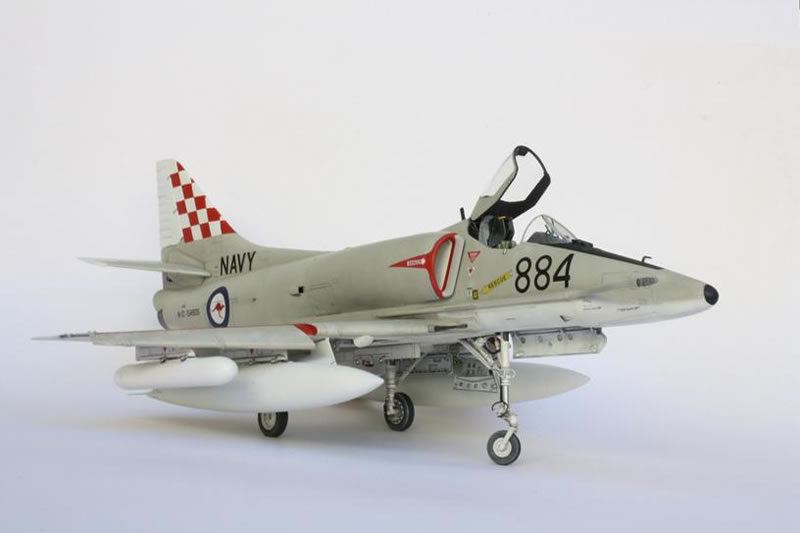
The Kit
The Trumpeter A4E kit is, for the most part, a good improvement over the venerable Hasegawa version. Its overall shape is good and the engraved panel lines sharp but restrained. Detail is a little variable. Notable among these is very well detailed cockpit side walls, let down by very poor detail on the side consoles, a nose wheel moulded integrally with its leg, a large gap between fin and rudder, and somewhat undersized and under-nourished air intakes. However, even if these few shortcomings are not corrected, the kit still builds up into a nice model. However, being a sufferer of advanced modeller syndrome (I think ‘advanced’ refers to age rather than thinking these things through) I attempted to correct these various shortfalls, primarily by raiding parts off an old Hasegawa kit picked up for a few dollars at a swap-meet and using a resin seat from AMS Resin.
The Improvements
Cockpit
Trumpeter offers a decal for the instrument panel. I suggest using it as the panel is so well hidden once installed it can barely be seen. The Trumpeter side walls and rear cockpit walls are very nicely done and include both quilting and map pockets. They respond very well to a dark wash and dry brushing over a fairly light grey base coat. Trumpeter would have you use decals for the side consoles – if so, at least add a throttle on the left side. However, I grafted on the consoles from my old Hasegawa version. Under a coat of paint, dry-brushing and detail painting these really come out well. As mentioned, I used a very nice resin seat from AMS Resin which included moulded on seat belts. Later in the build I found it necessary to add some structure inside the rear of the canopy as without it there’s no way of posing the canopy open.
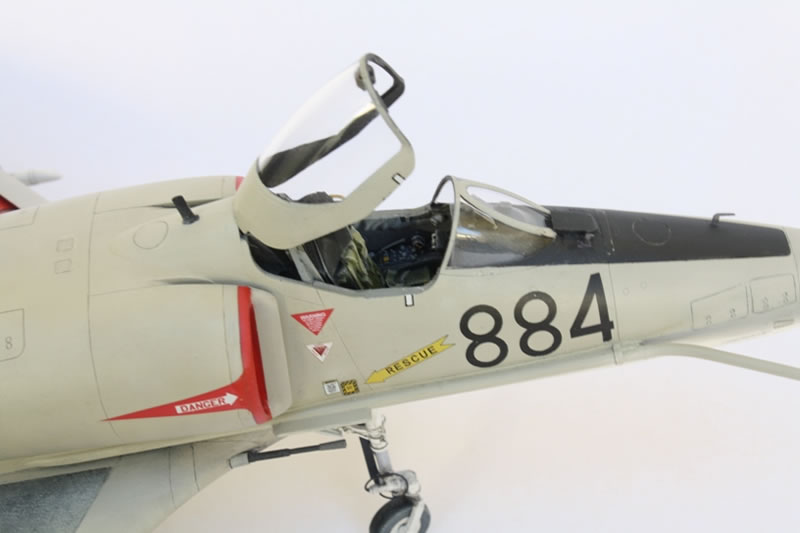
Intakes
While the intake trunking and engine face go together well and look good when finished, the same can’t be said for the front part of the intakes. Trumpeter appears to have taken the outer shape of the intake from the A4C, then added a simplified boundary layer splitter plate. For any version from the A4E onward the intake lips should be considerably thicker, while the opening itself should be deeper. The boundary layer splitter plate should appear to blend into the intake rather than look like a separate flat panel. When viewed from the side of the aircraft, the lower edge of the intake duct should be virtually a straight line for its full length, not curve upward at the front as much as Trumpeter have done. I addressed this quite simply by using the Hasegawa intakes.
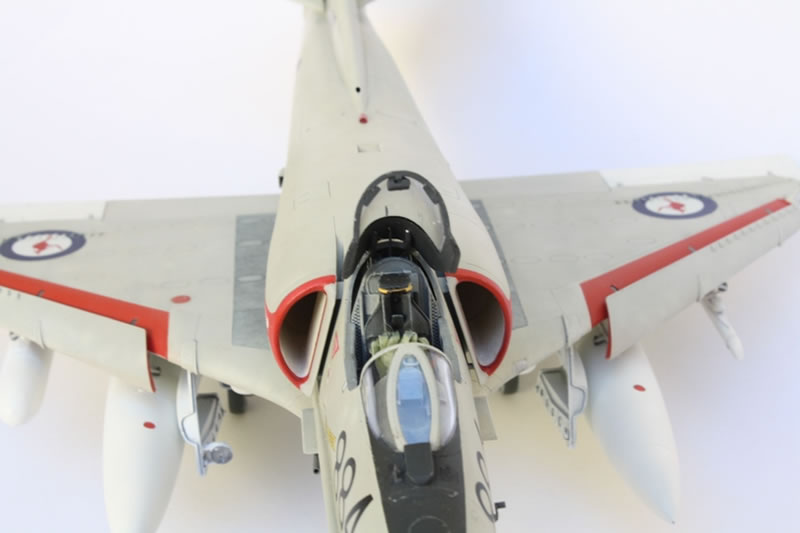
Wings
These are well done. However, to enhance them, I lightly filed each of the flow vanes on the inside of the “L” shape to make each vane and base plate finer. Beneath the wings a small ledge was added inside the flap opening to provide something to glue the flaps to later in the open position. I also had a little trouble with the thickness of the outer wing area. Initially, I simply glued the upper and lower wing surfaces to each other, but later found this was much thinner than both the aileron and wing tip transparencies. I therefore had to split the wing tip and add a little packing inside. Next time I will make the aileron first and do a little dry fitting and packing of the major wing parts before committing to glue. I also addressed the large step near the leading edge. This step allows the slats are to be glued shut. However, the slats were always open when the aircraft was on the ground (except for Blue Angels aircraft which had them wired permanently shut) and there is no large step on the 1:1 version. To remove the step, I cut out this section of the upper wing surface (the red part), created a small lip inside the wing and then glued the leading edge back into position without any step. The edges of the small transparency in the port wing leading edge should be aligned fore and aft, not perpendicular to the leading edge. I chose to replace this transparency, but a bit of clever painting might have done just as well.
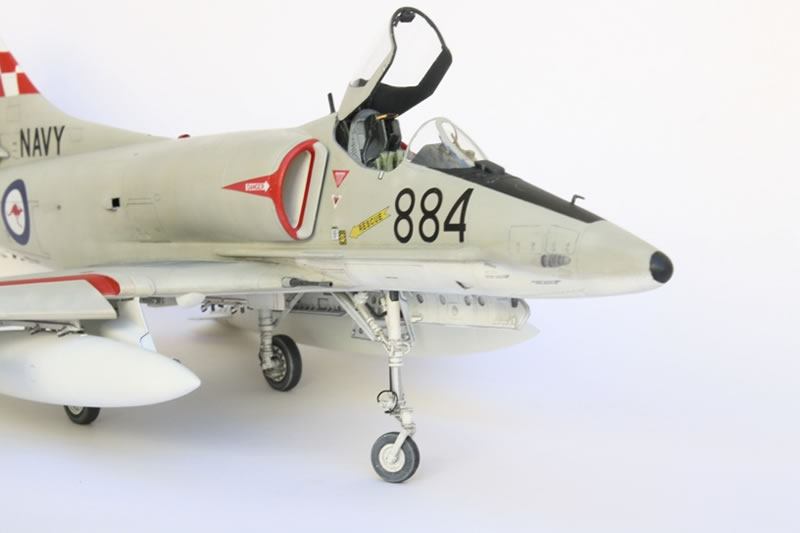
Tail
Again, most aspects are well done, particularly the separate base plates for the tail planes. However, on the 1:1 version the curved guides at the back of these base plates didn’t move with the base plates, they remained attached to the fin only. So, if the tail planes are to be posed in the fully ‘up’ position, separate these guides and remount them in the neutral position. There should also be a large opening in the fin that is normally hidden by these base plates when they are in the neutral position. Finally, there is a very large gap between the fin and the base of the rudder. I found it easier to add sheet plastic to the fin then blend it in to fill the gap, rather than add to the base of the rudder and risk damaging the very nice external rib mouldings. The top of the rudder is moulded integrally with the fin; I separated this and added it to the top of the existing rudder to give a consistent hinge line over the full length.
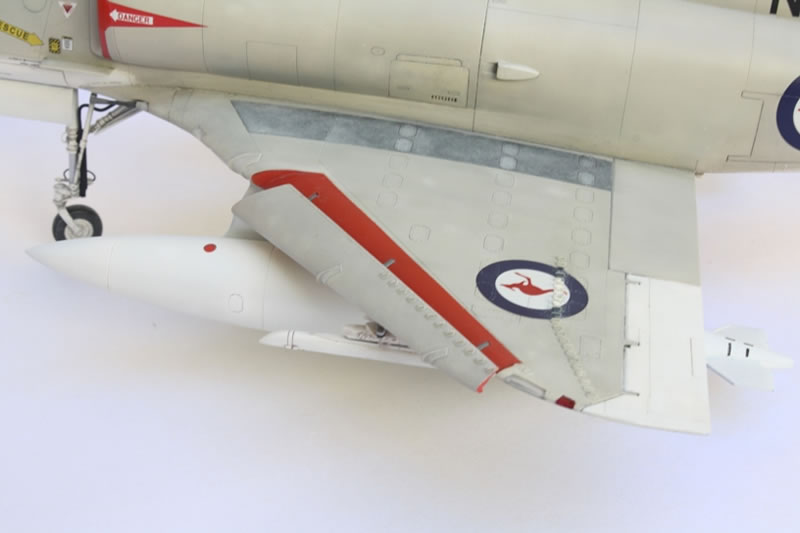
Undercarriage
Trumpeter has chosen to mould the nose wheel and the nose leg as a single part. While some careful painting might have hidden this, having already acquired a cheap swap-meet Hasegawa kit, I simply grafted on the lower part of the Hasegawa leg and used the nose wheel from that kit. Because I had them available, I also replaced Trumpeter’s main wheels and synthetic tires with the Hasegawa ones. Piping detail for the nose leg also came from the Hasegawa kit, though scrap plastic and wire could have done just as well. Hydraulic lines were added to the main legs from copper wire.
A-4E to A-4G
While not strictly improvements, converting from the A4E in the box to an A4G involved only two modifications. The first was removal of the chaff dispensers below the rear fuselage. This was filled and reinforced from the inside before later filing down from the outside. The second was the angled refuelling probe, which was a feature of the A4Gs for most of their service. This was made from aluminium tube with a brass wire insert to stop the tube crushing at the bends. The brass wire extends a little beyond the tube to provide for a strong pinned joint to the fuselage. At the outer end, the same pin arrangement was used to join the Trumpeter probe connection to the aluminium tube. Why aluminium tube and not brass? It’s easy to file down to the correct diameter to match the kit part.
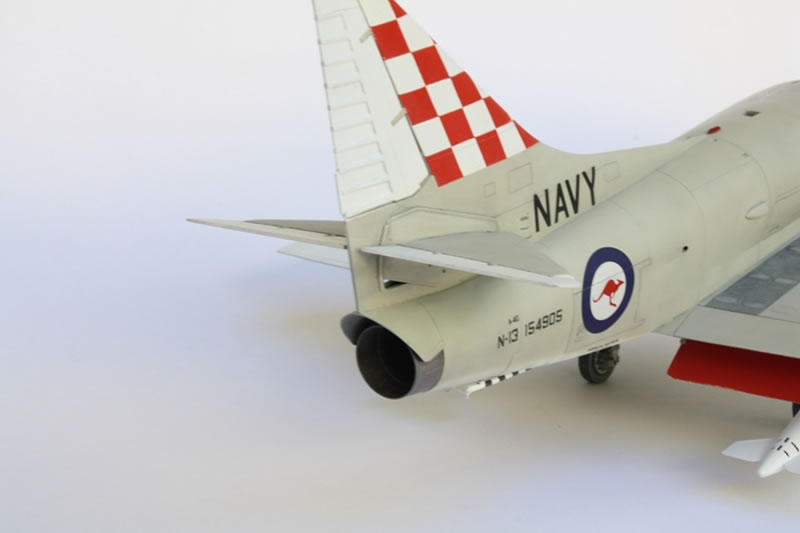
Painting
All painting was done with enamels. I tend to use Revell white as the Humbrol offering discolours and turns brown very quickly. The remainder was done with a patchy combination of Light Aircraft Grey, Light Gull Grey and even a little white and Medium Sea Grey to get subtle variations in tone. The walkways were initially painted a very dark grey then dabbed while still not fully dry with an old t-shirt which had been dipped in a puddle of a medium grey. Think ‘dry-brushing’ but with a t-shirt and a ‘dabbing’ motion to build up a coarse and uneven effect. Panels and edges within the walkway were highlighted by dabbing through or around a scribing template.
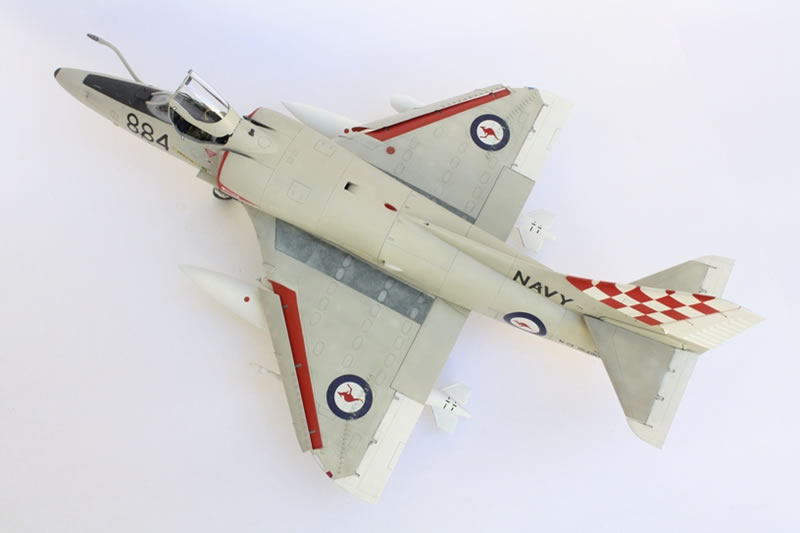
Markings
Markings came from the Aussie Decals sheet, though the chequers on the fin were masked and sprayed instead. Those few Trumpeter stencils and intake warnings that were used performed very well. However, I noted that the full colour US stars and bars in the kit were absolute rubbish (rounded tips on the stars!) so would need to be replaced if I built a standard USN A4. They may have been corrected in later boxings.
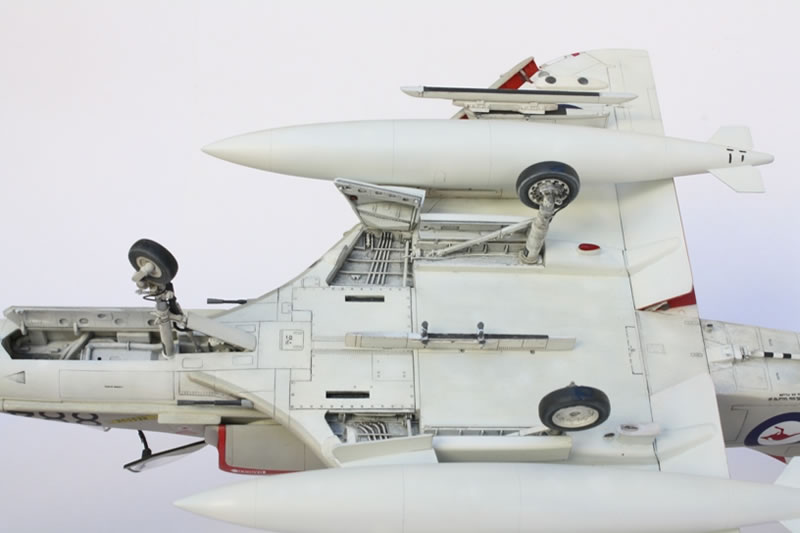
Conclusion
Overall, this was an enjoyable kit to build. Out of the box it still looks like a Skyhawk and is a marked improvement over the old Hasegawa offering. However, for the fussier amongst us, there are few details that can be improved.
References
Phantom, Hornet and Skyhawk in Australian Service, Stewart Wilson, Aerospace Publications
© Mike Prince 2014
This article was published on Sunday, June 29 2014; Last modified on Friday, February 10 2017
